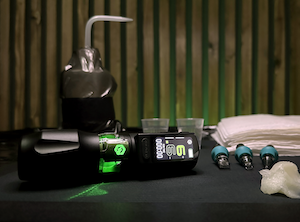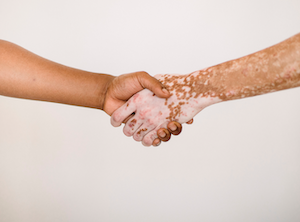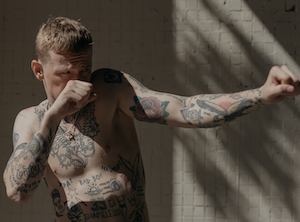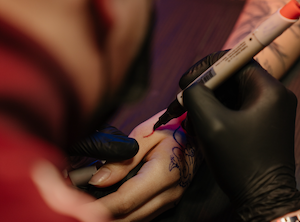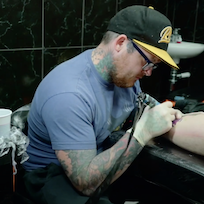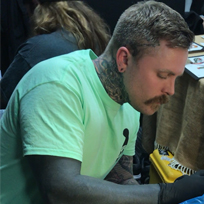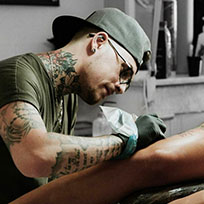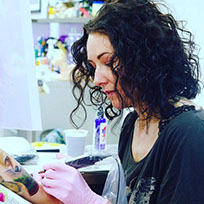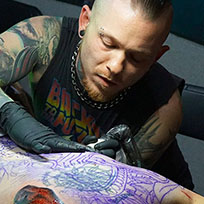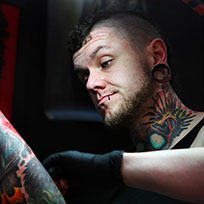A tattoo should have healed in the outer layers of the skin after about 2-3 weeks to such an extent that there are no more restrictions on your lifestyle. However, the complete tattoo healing process in all skin layers will take about 4-6 months.
This isn’t a one-size-fits-all process though so we can’t give you an easy answer to “How long does it take for a tattoo to heal?” It varies greatly depending on a variety of factors. A simple small tattoo for example with only black ink will heal much faster than a large, detailed tattoo with colours. Your skin type, your lifestyle and your physical condition also determine the healing time of your tattoo. Here we’ve detailed the most important tattoo healing stages as well as what you need to be aware of when going through each one.
After getting the tattoo
After tattooing, your tattooist will have wrapped your tattoo securely, either in the traditional way with cling film or with what’s known as a ‘second-skin’ product such as Tattoomed or Dermalize. At this point, your fresh tattoo will feel like a scrape and will burn a little, whilst also having some redness to it.
After a few hours, you’ll more than likely be ok to remove the cling film but please take the advice of your tattoo artist as they will know what works best for their style (different rules apply to second-skin). You will notice at this point that your tattoo is oozing. This is your body protecting the open wound with plasma which pushes any germs out.
In this healing stage, you must be particularly careful with your tattoo. You should avoid exposing the tattoo to direct sunlight and be careful to keep it as clean as possible. Sports and saunas are absolutely taboo in this phase as sweat and irritation can lead to inflammation. The same applies to swimming, as swimming pools and open water are full of bacteria.
To read the best tips for aftercare, check out our post on Tattoo Aftercare: 16 Tips for Looking After a New Tattoo.
The tattoo healing process starts
On the second day, the tattoo will have now dried and started to scab. The tattoo is still sensitive and will hurt when touched (which you should avoid if possible). Your top layers of skin are now trying to heal and to close the skin for the further healing still to come.
In this phase you should continue to make sure that your tattoo is as clean as possible and that your skin has optimal healing conditions. The best way to do this is to drink a lot (alcohol-free, of course), eat a healthy diet and keep the tattoo as protected as possible. Sport and swimming are still not possible in this phase because the risk of infection is very high.

How long will the redness last on my tattoo?
In the first week, scabs should form on the tattoo and the redness should slowly go away. If the redness doesn’t go away, the tattoo may be inflamed. In that case, you should consult with your tattoo artist who will tell you what to do.
When does a tattoo stop itching?
As your skin heals, your tattoo may itch. That’s a good sign, because it means your body is working to repair the skin. You should avoid scratching it in any case. A good tattoo healing cream that you apply thinly on the tattoo can provide some relief.
Also in this phase, you should make sure to keep your tattoo free from friction, as this could damage the scabbing and interfere with the healing process. Bathing should still be avoided as the scabs would soften and bacteria could penetrate the reopened wound.
When will the scabbing go away?
In the second week, the scabbing should slowly go away, and you will already be able to see the freshly healed layers of skin on your tattoo. However, you should keep in mind that only the upper skin layers above the tattoo have newly formed. The lower layers of the skin are still in the tattoo healing process and it will take a while until they have fully regenerated. Since the new protective skin still doesn’t cover all areas of the tattoo, swimming and bathing should be avoided.
In the early healing phase, you should continue to clean the tattoo regularly with a cleansing aftercare product as well as applying your chosen tattoo healing cream so that it doesn’t dry out and can continue to heal. Of course, direct sunlight should also be avoided.

What is silver skin and when will it disappear?
After 3 weeks or so, the scabs should have completely fallen off and a thin layer of skin should have appeared over the tattoo. This layer of skin is called ‘silver skin’ and will make the tattoo look a little shiny and dull. The brightness will return in time once the tattoo is fully healed.
In this phase you can go swimming and take baths again, but you should make sure that the tattoo in the upper skin layer (epidermis) has healed completely and the skin is completely closed.
How long should you wait after a tattoo to play sports?
Physical exercise is not recommended in the immediate period after getting a tattoo due to the risk of injury, as the scabs could tear open due to stretching or touching and sweat could penetrate the tattoo. However, after a couple of weeks light sporting activities (e.g. cycling) can be carried out as long as the tattoo is not being stressed too much (stretching, friction). Sports that are at risk of damaging the thin skin should therefore be avoided. Direct sunlight should also be avoided, since the thin layer of skin cannot protect the tattoo colours.
Once the upper layers of your skin have healed (after about 3 weeks), you can start exercising again, however, you should make sure that you apply aftercare to the tattoo before working out as well as cleaning and applying aftercare to your tattoo post-workout.
After about a month your tattoo will have healed and it feels as if the tattoo colours have already become part of your skin. The skin feels smooth, and the epidermis is completely healed. However, the underlying skin layers (dermis) will still take a while to heal completely and to absorb the colour completely. In this phase, you no longer need to take special care of the tattoo. It doesn’t hurt, however, to apply tattoo cream from time to time and to be careful not to hurt the skin on top of the tattoo.
Can’t wait to get back into the sauna after your tattoo? After about a month you can go back to the sauna, swimming and do sports as you like. If in the sun too, you should always make sure that you cover the tattoo or at least protect it with sunscreen. There are special tattoo sunscreens with a high sun protection factor that optimally protect your tattoo.

When has a tattoo completely healed?
After 6 months, your tattoo has completely healed in all skin layers and the colour has been completely absorbed by your skin. You can now treat the tattooed area like the rest of your skin. Keep in mind though that your tattoo will age over time, just like your skin.
If you have dry skin, you should apply aftercare regularly so the skin stays hydrated and the colours stay vibrant. Your skin lives and so does your tattoo; fine lines will get thicker and initially visible dots in shades will sink further into the skin and blur a little. The actual result of a tattoo can usually be seen at this time.

Your tattooed skin will now react like the rest of your skin and you can swim, take baths and exercise as before. However, you should still make sure to use a sunscreen with a high sun protection factor (SPF) on the tattooed area to protect your tattoo from the sun. If you don’t, your tattoo will look duller and lose its vibrancy and colour intensity over time.
If you want to know, what time of the year is the best to get tattooed, check out our blog on When is the Best Time to Get a Tattoo?













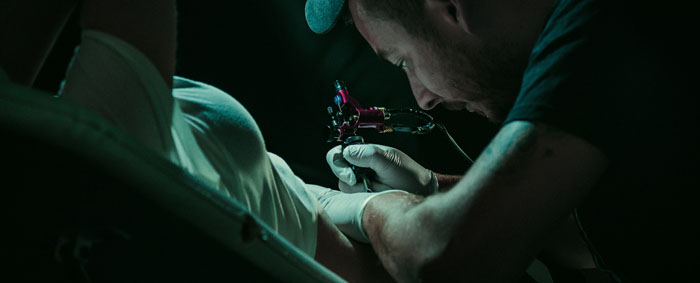
 What Is A Prince Albert Piercing?
What Is A Prince Albert Piercing?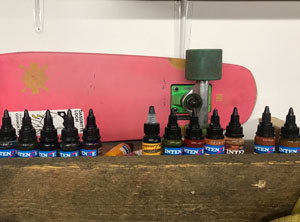 The Best Tattoo Ink 2024
The Best Tattoo Ink 2024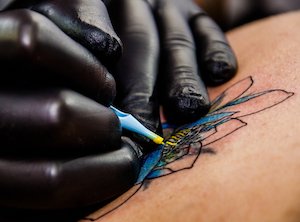 Tattooing Over Stretch Marks, Moles, Scars And Other Skin Conditions
Tattooing Over Stretch Marks, Moles, Scars And Other Skin Conditions 11 Best Fonts For Tattoos 2022
11 Best Fonts For Tattoos 2022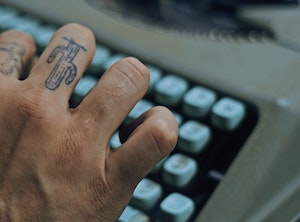 Advice For An Itchy Tattoo
Advice For An Itchy Tattoo
